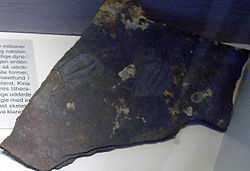Buenellus
| Buenellus higginsi Temporal range: Atdabanian | |
|---|---|
 | |
| Buenellus higginsi fossils at the Geological Museum, Copenhagen | |
| Scientific classification | |
| Kingdom: | Animalia |
| Phylum: | Arthropoda |
| Class: | Trilobita |
| Order: | Redlichiida |
| Suborder: | Olenellina |
| Superfamily: | "Nevadioidea"[1] |
| Family: | "Nevadiidae" |
| Genus: | Buenellus Blaker, 1988 |
| Species: | B. higginsi |
| Binomial name | |
| Buenellus higginsi Blaker, 1988 | |
Buenellus higginsi, is an average size (about 5 centimetres or 2.0 inches) trilobite, which lived during the Lower Cambrian period, in what is presently North-West Greenland. It is a prominent member of the Sirius Passet fauna. Buenellus higginsi is the only known species in the genus Buenellus (i.e. the genus is monotypic).
Etymology
The genus name is a contraction of Buen, from the formation in which is was first collected, and Olenellus, a somewhat related trilobite genus. The species specific epithet honors A. Higgins, who discovered the Sirius Passet Lagerstätte in 1984 during the Geological Survey of Greenland.
Description
General outline of the body is rounded the front ⅓, parallel sided the middle ⅓ and progressively tapering backwards in the back ⅓, ending at an angle of approximately 45° with the midline. Headshield (or cephalon is approximately ⅝× as long as wide. The (in this case only slightly) vaulted central axis in the head or glabella tapers gently forward and does not reach the anterior margin. The outer backside of the cephalon (or genal angle)has short genal spines. The thorax has 17 or 18 articulating segments, maintaining width or widening slightly backward to 8th segment, then tapering posteriorly. The posterior segment may be fused with anterior part of a simple and small pygidium. Pleural spines are short, and the pleural regions only slightly wider than the axis.[2][3]
Differences with other Nevadiidae
The general shape of the body of other species in the Nevadid family (like Nevadia and Nevadella) is shorter, with the greatest width across the back of the cephalon, and the entire thorax tapering backwards.
Distribution
Buenellus higginsi, has been collected from (early to middle Atdabanian) at the lower Buen Formation (“Nevadella” Zone), Sirius Passet at its junction with the J. P. Koch Fjord, Peary Land, Greenland 82°47′6″N 106°12′7″E / 82.78500°N 106.20194°E. It has also been reported from Novaya Zemlya, Russian Republic.
Ecology
Mineral-filled gut tracts in B. higginsi suggest they were not filled with sediment at the time of burial, and that the species was a predator of soft prey.
Healed injuries, some of which are the result of unsuccessful predaceous attacks, are uncommon in B. higginsi. Carnivory on B. higginsi is also implied by the remains of anomalocaridids and other potential predators.[4]
Other exoskeletons show evidence of post-mortem disruption, perhaps because of scavenging. Buenellus higginsi, one of the earliest known trilobites from Laurentia, seems to have played an important role in the Sirius Passet ecosystem, serving both as predator on, and prey for, contemporary animals.[5]
Habitat
Buenellus higginsi was probably a marine bottom dweller, that lived in deeper water. This may be deduced from the dominance of eyeless forms and the absence of seaweeds at the collection site.[6]
Soft tissue preservation
Many specimens of B. higginsi show some form of exceptionally preserved, non-biomineralised tissue. Structures interpreted as alimentary tracts and probable digestive glands are commonly preserved. The slender antennas are rarely preserved.[5]
References
- ↑ Lieberman, B.S. (1998). "Cladistic Analysis of the Early Cambrian Olenelloid Trilobites". Journal of Paleontology. 72, part 1: 59–78.
- ↑ Mark R. Blaker & John S. Peel (1997). Lower Cambrian trilobites from North Greenland. Meddelelser om Grønland. Geoscience 35. ISBN 978-87-635-1241-1.
- ↑ H. B. Whittington et al. (1997). "Introduction, Order Agnostida, Order Redlichiida". Treatise on Invertebrate Paleontology. Part O, Revised. Trilobita.
- ↑ Loren E. Babcock (2002). "Anatomy, paleoecology, and taphonomy of the trilobite Buenellus from the Sirius Passet biota (Cambrian), North Greenland". Geological Society of America Annual Meeting. Denver, Colorado. paper no. 75-8.
- ↑ 5.0 5.1 Loren E. Babcock & John S. Peel (2003). "Palaeobiology, taphonomy and stratigraphic significance of the trilobite Buenellus from the Sirius Passet biota, Cambrian of North Greenland". Memoirs of the Association of Australasian Palaeontologists 34: 401–418.
- ↑ John S. Peel & Martin Stein (2009). "A new arthropod from the Lower Cambrian Sirius Passet fossil-Lagerstätten of North Greenland" (PDF). Bulletin of Geosciences 84 (4): 625–630. doi:10.3140/bull.geosci.1158.
External links
-
 Data related to Buenellus at Wikispecies
Data related to Buenellus at Wikispecies